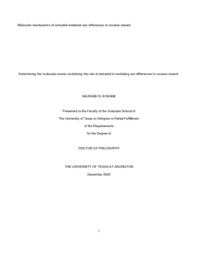
ATTENTION: The works hosted here are being migrated to a new repository that will consolidate resources, improve discoverability, and better show UTA's research impact on the global community. We will update authors as the migration progresses. Please see MavMatrix for more information.
Show simple item record
| dc.contributor.advisor | Perrotti, Linda I | |
| dc.creator | Kokane, Saurabh Sanjeev | |
| dc.date.accessioned | 2022-01-21T19:28:04Z | |
| dc.date.available | 2022-01-21T19:28:04Z | |
| dc.date.created | 2020-12 | |
| dc.date.issued | 2020-12-08 | |
| dc.date.submitted | December 2020 | |
| dc.identifier.uri | http://hdl.handle.net/10106/30184 | |
| dc.description.abstract | Research has demonstrated that women rapidly progress from recreational cocaine use to dependence, consume greater quantities of cocaine, experience more positive subjective effects of cocaine and have higher incidences of relapse during abstinence. These effects have been well replicated in animal models of cocaine addiction and indicate an enhanced sensitivity and therefore, vulnerability of females to cocaine addiction. This increased vulnerability of women and female animals to cocaine addiction has been attributed to enhanced cocaine reward. Furthermore, it has been demonstrated that the female hormone estradiol (E2) is a key mediator of the aforementioned effects of cocaine in women and female animals. For example, higher levels of E2 correspond to enhanced rewarding effects of cocaine, therefore increased cocaine consumption and higher incidences of relapse. However, studies identifying the influence of E2 on cocaine-associated reward and its underlying neurobiological mechanisms are severely lacking. Preliminary evidence from our laboratory demonstrated that female animals have increased sensitivity to cocaine-conditioned reward – measured by conditioned place preference (CPP) – and this increased sensitivity is mediated by increased circulating levels of E2 when animals are getting conditioned to cocaine reward. In the present study we have further explored the influence of increased levels of E2 during cocaine conditioning in females and demonstrate that, indeed, E2 mediates cocaine-conditioned reward by potentiating cocaine-context associations. Additionally, we observed that E2-mediated increases in cocaine-CPP were associated with increased activation of ERK1/2 and mTOR proteins in the mesolimbic reward pathway. To experimentally assess the involvement of ERK1/2 and mTOR in E2-mediated enhanced cocaine-CPP, we systemically inhibited ERK1/2 and mTOR activity during cocaine-conditioning. Systemic inhibition of ERK1/2 phosphorylation during conditioning inhibited cocaine-CPP in females whereas mTOR inhibition during conditioning did not. In conclusion, we have established that E2 enhanced cocaine-conditioned reward by potentiating cocaine-context associations formed during the cocaine-conditioning. ERK1/2 activation during cocaine-conditioning is necessary for the potentiation of cocaine-conditioned reward by E2. While, mTOR activation during cocaine-conditioning does not influence E2-mediated enhancement of cocaine-conditioned reward. This is the first study assessing the interaction between E2, ERK1/2 and mTOR signaling, and E2-mediated cocaine conditioned reward. | |
| dc.format.mimetype | application/pdf | |
| dc.language.iso | en_US | |
| dc.subject | Cocaine reward | |
| dc.subject | Estradiol | |
| dc.subject | Sex-differences | |
| dc.subject | ERK | |
| dc.subject | mTOR | |
| dc.subject | Conditioned place preference | |
| dc.subject | SL327 | |
| dc.subject | Rapamycin | |
| dc.subject | Cocaine-conditioned reward | |
| dc.title | Determining the molecular events underlying the role of estradiol in mediating sex differences in cocaine reward. | |
| dc.type | Thesis | |
| dc.degree.department | Psychology | |
| dc.degree.name | Doctor of Philosophy in Psychology | |
| dc.date.updated | 2022-01-21T19:28:05Z | |
| thesis.degree.department | Psychology | |
| thesis.degree.grantor | The University of Texas at Arlington | |
| thesis.degree.level | Doctoral | |
| thesis.degree.name | Doctor of Philosophy in Psychology | |
| dc.type.material | text | |
Files in this item
- Name:
- KOKANE-DISSERTATION-2020.pdf
- Size:
- 2.090Mb
- Format:
- PDF
This item appears in the following Collection(s)
Show simple item record


